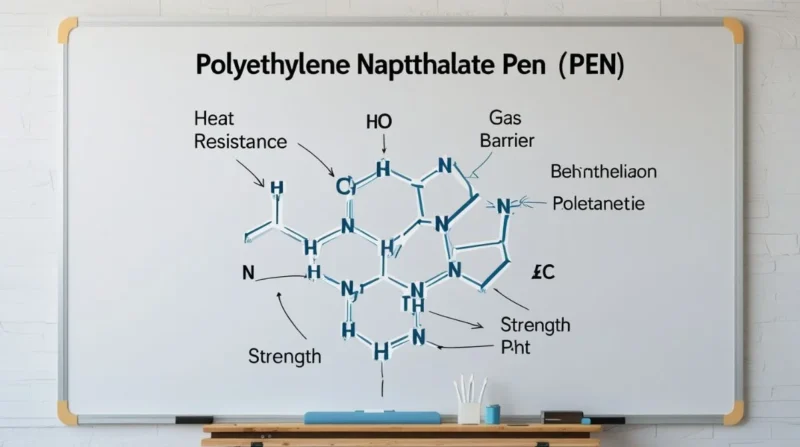Table of Contents
Polyethylene naphthalate, commonly known as PEN, is a type of plastic that stands out for its strength, heat resistance, and ability to keep out gases and moisture. It’s similar to the more familiar PET (polyethylene terephthalate) but offers enhanced performance in several areas. These qualities make PEN a preferred material in industries like packaging, electronics, textiles, and automotive.
Understanding Polyethylene Naphthalate
PEN is a polyester made by combining ethylene glycol with naphthalene-2,6-dicarboxylic acid. This combination results in a material with a tightly packed molecular structure, giving it superior mechanical and thermal properties compared to PET. Its structure allows for better barrier properties, making it ideal for applications where protection from oxygen, moisture, and other environmental factors is crucial.
What Is the Formula of Polyethylene Naphthalate?
The chemical formula of polyethylene naphthalate (PEN) is:
(C₁₄H₁₀O₄)n
This formula represents a repeating unit of the polymer made up of carbon, hydrogen, and oxygen atoms. PEN is formed through a chemical process called polycondensation.
How to Make Polyethylene Naphthalate?
To make PEN, two main ingredients are used:
- Ethylene glycol
- Naphthalene-2,6-dicarboxylic acid (NDC)
When these two compounds react, they release water molecules and form long chains of polymer. These chains create the material known as polyethylene naphthalate.
Because of its tightly packed molecular structure, PEN shows excellent strength, high thermal stability, and superior resistance to gas and moisture, making it a high-performance alternative to PET in many industries.
Key Properties of PEN
PEN’s unique characteristics make it suitable for demanding applications. Some of its notable properties include:
- High Thermal Stability: PEN can withstand higher temperatures without deforming, making it suitable for hot-fill packaging and electronic components.
- Superior Barrier Properties: It offers excellent resistance to gas and moisture permeation, which helps in preserving the freshness and extending the shelf life of packaged goods.
- Enhanced Mechanical Strength: PEN exhibits higher tensile strength and rigidity, providing durability in various applications.
- UV Resistance: Its ability to resist ultraviolet light degradation makes it suitable for outdoor applications and products exposed to sunlight.
- Chemical Resistance: PEN is resistant to a wide range of chemicals, ensuring longevity in harsh environments.
Common Uses of PEN
Thanks to its robust properties, PEN is utilized across various industries:
- Packaging: PEN is used in food and beverage packaging, especially for products sensitive to oxygen and moisture. Its barrier properties help maintain product quality over time.
- Electronics: In the electronics sector, PEN serves as a substrate for flexible printed circuits and insulation materials due to its thermal stability and dielectric properties.
- Textiles: PEN fibers are employed in high-performance textiles, offering durability, dimensional stability, and resistance to chemicals and UV light.
- Automotive: The automotive industry uses PEN for components that require strength and heat resistance, such as under-the-hood parts.
- Optical Applications: PEN’s clarity and UV resistance make it suitable for optical films and protective layers in displays and solar panels.
Advantages Over PET
While both PEN and PET are polyesters, PEN offers several advantages:
- Better Heat Resistance: PEN can handle higher temperatures, making it more suitable for applications involving heat exposure.
- Improved Barrier Properties: It provides superior protection against gas and moisture, enhancing the shelf life of packaged products.
- Greater Mechanical Strength: PEN’s rigidity and strength surpass those of PET, offering better performance in demanding applications.
- Enhanced UV Resistance: PEN resists degradation from ultraviolet light more effectively than PET, making it ideal for outdoor use.
Environmental Considerations
PEN is recyclable, and efforts are ongoing to improve its recyclability and reduce production costs. Its durability and resistance to degradation mean that products made from PEN have a longer lifespan, potentially reducing waste over time. Additionally, research into bio-based production methods aims to make PEN more sustainable.
PEN vs. PET: How Do They Compare?
Polyethylene naphthalate (PEN) and polyethylene terephthalate (PET) are both types of polyesters, and at first glance, they may seem quite similar. However, their performance varies significantly due to differences in their chemical structures. While both materials are made from ethylene glycol, PEN uses naphthalene dicarboxylic acid, whereas PET uses terephthalic acid. This small variation gives PEN a stronger, more compact molecular structure.
Here’s how they compare across key factors:
Thermal Resistance
PEN performs better under high temperatures. It can withstand more heat before deforming, which makes it ideal for hot-fill packaging and high-temperature industrial uses. PET, on the other hand, starts to deform at lower temperatures.
Barrier Properties
PEN provides a higher barrier against oxygen and moisture. This is critical for food and pharmaceutical packaging that demands long shelf life. PET is good but not as effective in this area.
UV Resistance
PEN resists UV light degradation much better than PET, making it more suitable for outdoor and light-sensitive applications.
Mechanical Strength
PEN has higher tensile strength and rigidity, giving it the edge in situations that require tough and durable materials.
Cost and Availability
PET is cheaper and more widely available. That’s why it dominates the packaging and textile industries. PEN, being more expensive, is usually reserved for applications where its superior properties justify the cost.
Recyclability
Both materials are recyclable, but PET has a more established recycling system worldwide. Efforts are growing to improve PEN recycling, especially as demand for high-performance plastics increases.
Visual Clarity
PET offers excellent clarity, which is why it’s commonly used for water and soda bottles. PEN also has good clarity but is typically used in specialty applications where performance matters more than appearance.
Polyethylene Naphthalate vs. PET: The Smarter Choice
Polyethylene naphthalate (PEN) has carved out a strong position as a high-performance material for industries that demand durability, heat resistance, and long-term protection. While PET remains popular for its affordability and availability, PEN clearly leads when performance matters most. From advanced packaging to high-tech electronics and tough automotive components, PEN delivers where others fall short. As industries continue to push for stronger, smarter, and more sustainable materials, polyethylene naphthalate is proving to be a future-ready solution worth considering.
Related Topic: Methyl Formate: Properties, Production, Uses, and Market Trends









